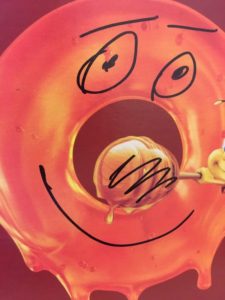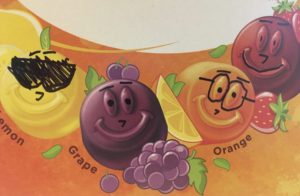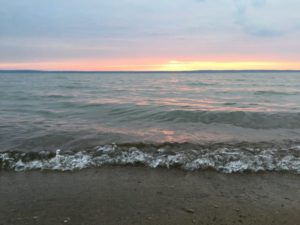I can’t take credit for the cool faces on all of these boxes. I have an artist in my home who learned this technique from a buddy. Since my son took it up, our home has exploded with fun faces that bust up the doldrums of household routines.

Just for giggles, here’s my how-to tutorial for Cereal Box Sharpie Art:
1.) Choose a cereal (or other) box.
2.) Grab a sharpie.
3.) Get creative.

How long has it been since you’ve given yourself complete creative freedom? When was the last time you recklessly abandoned the rules and thought, “What else could this be?” The ingenuity of this art form is its out-of-the-box thinking. Sorry guys, it just had to be punned.
Just in case you think I’m off my rocker, I’ll let you in on a little secret: I’m not a super-great artist. I love art, and I marvel at the classic, great artists who’ve earned every bit of their fame. But I am not, and will never be, one of those men or women.
I’m more of an “art-inspires-me-so-I-create” kind of artist. A lot of my work is just odd. I like it that way. But why in the world do I put it online for you to see and try for yourself?
Here’s the thing: I don’t care what category your profession falls under – healthcare, hospitality, computer software development, or waste management – every job needs innovative thinking. Are faces on cereal boxes innovative? Maybe, but they definitely shake things up, and they’re reminders.
Reminders that things can change.
So, if you’re stuck in any way, shape, or form in life, grab a sharpie and a box. Change it up! Remind yourself that even good things can be a little brighter when you add your creative thinking to them.
Until next time,
Invent your story

This seems like the easy part of creating an invention center – you just get the supplies you need. The thing is, without a method to the madness, it’s just madness. So here are three plumb line questions to keep you stockpiling instead of just making piles.
Does the material fit into the goal of your invention center?
I know I haven’t brought up the term “goal” in the context of your invention center before, but if you’ve come this far, you probably have a good idea of what yours is already. (If you haven’t read the first two posts on creating an invention center, you can read what it is and Part 1 to get caught up.) If you’re woodworking, you’ll need wood, screws, a drill, etc.
This is the no-brainer stuff to have around. Without a stocked area, you’ll get bogged down looking for that lost paintbrush or copper wire. This is why we’re making an invention center.
How much do you need to get started?
Sometimes the zeal to create can take over, and you end up with a lot more than you need – especially if it’s freebie stock. Like toilet paper rolls. There are tons of art and engineering projects you can do with toilet paper rolls. But if you keep saving and don’t use them, well it can just start to get weird.
There has to be a FULL point. Then move on.
Did you throw a wrench in your plan?
If the answer to the last question is “nope” – then it’s time to find that wrench and throw it into the stockpile! Hear me out on this one. If you want to create a maker’s space, that’s great, but this is a defining moment for your invention center. You want to have something in your invention center that challenges you to break the mold. More than something. A fair lot of things. An acorn from last fall’s hike. A bunch of rusty nails. One red sock.
These are the grains of sand that help your creative oyster make a pearl.
Until next time,
Invent your story
I like to look at the lives of inventors and try to learn from them. They’re inspiring and worth studying! We live in a world full of wonderful inventions, so it’s natural to point to a computer and ask, “Who made that?” This summer, I went camping, and every night, I took a picture of the sunset. Here’s one.

It’s beautiful. How does it happen? Seeing the water, the light, the air, the earth, and the sun all working together makes me ask: is there an inventive mastermind behind that? In school these days, sometimes kids are told not to talk about religion and science – what people around the world believe – and I think that does everyone an enormous disservice. Learning how to have a respectful conversation about our differences and similarities of beliefs and points of view helps all of us.

Because at some point in life, we start asking questions. How did I get here? How did you get here? Where did all of this stuff come from? How does it work? And there’s endless, wonderful ideas out there. As we study, we get answers that invite more questions.

So, today I’m inviting you to ask the questions, encouraging you to look for answers, and letting you know what I think about it all. I think none of this – not an atom in the cosmos – is an accident or chance. I believe there is a God who created every person and everything. Why do I believe that?

For a few reasons. People who believe in God have talked to me about what they believe and why. I read in the Bible about God, Jesus Christ, and the Holy Spirit. I talked to God, listened, and started to believe. Here’s where I’m at:

It’s like gravity. Newton studied the force that attracts a body toward the center of the earth or toward any other physical body having mass – and it’s so cool that he did. I believe gravity is a real thing because what he said makes sense, even though I don’t understand it all, when I jump up, my body comes back down to the earth – hopefully, on my feet. It’s a “scientific theory” that’s also proved true over and over in my everyday experience of life – so yes, I believe in gravity.

When I look at the sunset, or smell salt in the air off the ocean, or hear children make up a funny song about macaroni noodles, and I wonder if there’s intelligent design behind it, all signs point to: yes.

What do you think about when you look at the sunset? As you move forward with your day today, I want to invite you to ask questions and explore the answers!
Until next time,
Invent your story

Psalm 19:1 The heavens declare the glory of God; the skies proclaim the work of his hands.
Another inventor who saw God in nature was George Washington Carver. Check out a slice of his life here!
